In August of 1776, Fort Defiance sat ready upon a rocky outcrop on the western edge of Brooklyn. Nothing more than large, earthen mounds, a modest garrison of men held their post against the world’s largest armada, anchored beyond them in the harbor. General Washington described the outpost in the sleepy hamlet of Red Hook as “small but exceedingly strong.” While this ragtag band of patriots may not have won the war that August, their willingness to brave overwhelming odds allowed the Continental Army to retreat safely beyond the grasp of the British forces. It was here the plucky American spirit of Red Hook was born.
Red Hook has had its fair share of gut-punches throughout its history: over-industrialization, gangs, crime and infamously being named “crack capital of America” by LIFE Magazine in 1990. But somehow, it survived — a little bruised, but no less committed to carrying on. St. John Frizell didn’t care about the community’s sketchy past when he opened Fort Defiance Cafe and Bar in 2009. There was something about this place. Something good he couldn’t quite put his finger on. “It had a post-industrial, rusted charm about it,” he says. “When I moved to New York City in 1999, I immediately started looking for a place to live in Red Hook. It reminded me of the bywater where I had lived in New Orleans. I finally found a place I liked in 2002.”
The neighborhood had begun to climb out of its depression, cleaning up its streets and gentrifying like so many other areas of Brooklyn. There were a few good bars and a couple of nice restaurants in Red Hook, but nothing where you could take your mother for a glass of wine when she was in town or have a breakfast meeting with a client. St. John kept waiting for a such a place, but it never materialized. After writing for Bon Appetit, traveling the world, and working under Audrey Saunders behind the bar at the famed Pegu Club, St. John finally gave Red Hook its neighborhood gathering spot. Little did he know the impact Fort Defiance would have on Red Hook and the lives of his patrons a mere three years later.
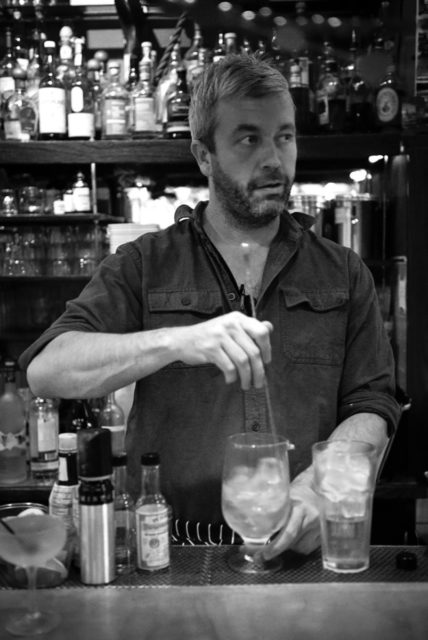 St. Jean Frizell was charmed by the “post-industrial, rusted” air of Brooklyn’s Red Hook neighborhood. It reminded him of his former home in the bywater of New Orleans.
St. Jean Frizell was charmed by the “post-industrial, rusted” air of Brooklyn’s Red Hook neighborhood. It reminded him of his former home in the bywater of New Orleans.
“I named it Fort Defiance because I wasn’t sure how fancy drinks in this neighborhood were going to go over. I didn’t want us to get teased. We were going to serve fancy cocktails, in fancy glasses, so it had to have a really butch name.”
For three years, Fort Defiance held its own, serving neighbors throughout the morning and afternoon while drawing in the big city crowd for cocktails at night. Life was pretty good.
On the evening of October 29, 2012, St. John looked out his apartment window toward Coffey Park. Hurricane Sandy had spent much of the day brutally battering the New Jersey coast with her winds and storm surge. He did his due diligence, as he had done a year before with Hurricane Irene, and moved inventory in the basement of Fort Defiance up four feet in case of light flooding. It had been raining, but no real damage had been reported. As the moon slipped out from behind the clouds, St. John saw its reflection on the water. Not in the harbor, but just beyond his building in Coffey Park.
“The water was coming up my street at a sort of walking pace. You could see the water advance. It was crazy. I knew Fort Defiance was lower in elevation than where I lived six blocks up. I didn’t know what was happening to it, but I knew it was going to be bad.”
It would be a couple of days before St. John knew just how bad it had been. The water receded, but what it left behind was a muddy, muck-filled mess. The flood waters filled the basement and up to 18 inches in the dining room at Fort Defiance. He was looking at major damage, complete loss of inventory, compressors and refrigerators destroyed, water-logged wood paneling and floors.
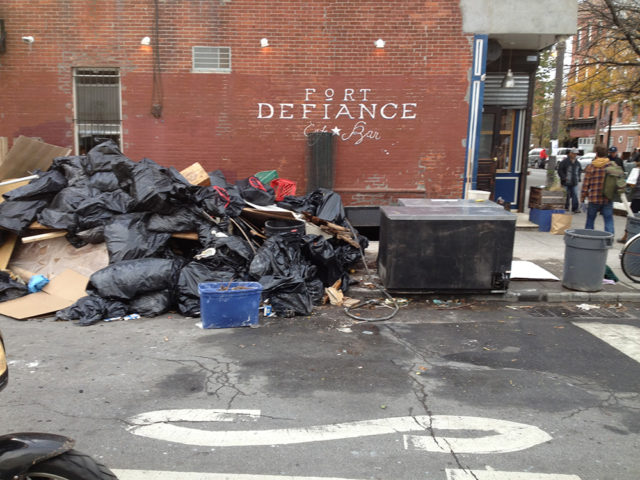 Seeing Fort Defiance after Superstorm Sandy was daunting; it seemed the work required to restore the neighborhood bar would be more than owner St. John Frizell could handle.
Seeing Fort Defiance after Superstorm Sandy was daunting; it seemed the work required to restore the neighborhood bar would be more than owner St. John Frizell could handle.
“The restaurant was three years old at that point. It was holding its own and breaking even but it wasn’t making a lot of money. It was an opportunity to walk away if I wanted to, and everyone would have understood. I thought about it. It was going to be a lot of work, cost a lot of money I didn’t have. So, okay, I’ll clean it up and sell it.”
But then something unexpected began to happen. People from all over Brooklyn, all across the city, were showing up in work clothes eager to get Fort Defiance back in the business of feeding the neighborhood. Each day, more and more volunteers, some of whom he never met, came to work in the cold, damp restaurant without heat. Days passed into weeks, and the muck and mud were disappearing. These were jobs he couldn’t have paid people to do. It was miserable work. No one complained.
“The thing that got me up in the morning was knowing I had people helping me down at Fort Defiance. I needed to be there to unlock the gates to let these volunteers in who were essentially saving my restaurant. I thought, wow, this place really means something to people”
There were still tough moments. Some of the hardest days were those he spent helplessly watching neighbors and friends desperately trying to salvage bits and pieces of their lives from the surge waters’ destruction. “Psychologically, that was difficult,” he says. “All of my friends who lived on the first floor of any building lost everything. In Red Hook, neighbors were always helping each other, but this time, we couldn’t — we were too busy saving our own homes and businesses.”
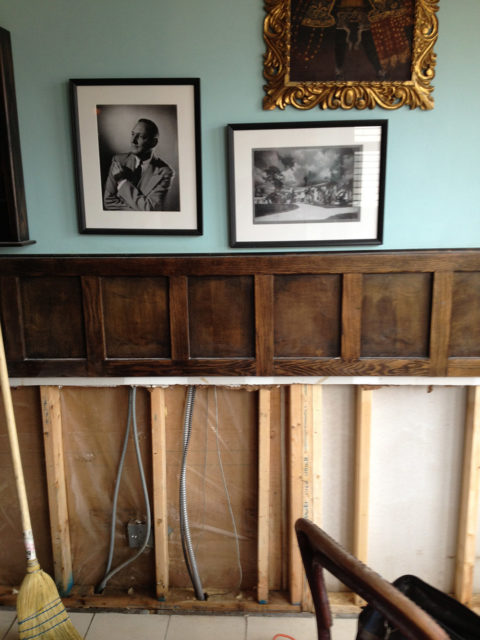 After Hurricane Sandy, Fort Defiance was in need of massive renovations, like retiling floors, restoring woodwork, and rewiring or replacing electrical panels; and the people of Red Hook donated their time and money to make it happen.
After Hurricane Sandy, Fort Defiance was in need of massive renovations, like retiling floors, restoring woodwork, and rewiring or replacing electrical panels; and the people of Red Hook donated their time and money to make it happen.
After three weeks, the volunteers began to fall off, but amazingly the grunt work had been done. What was left was for the skilled labor force of multi-talented friends, family, even other bartenders to tackle. Floors were tiled, woodwork was restored, and electrical panels rewired or replaced, all generously donated in the defense of Fort Defiance. St. John had applied for small government grants, but they didn’t amount to much. Red Hook residents and businesses were essentially on their own. He helped form a group of over 40 businesses called Restore Red Hook to gather donations to help with repairs. They managed to collect nearly $500,000, which was evenly distributed to the businesses involved in the coalition.
“Fort Defiance lost over $150,000 due to Sandy. It was enough to close us down. The help from the government was a drop in the bucket. It was Restore Red Hook and the generosity of volunteers, the Brooklyn community, my regulars, and even the U.S. Bartenders Guild (they bought me a new hot water heater and furnace) who were the driving force behind the restaurant’s physical recovery.”
Fort Defiance reopened its still bruised doors right after Thanksgiving, just five weeks after Sandy had threatened to keep them shut for good. To most, it was a triumph. A remarkable comeback against overwhelming odds. To St. John, it was simply necessary in order to retain his staff; a group of hard-working New Yorkers and Brooklynites who were cobbling their lives together since the storm with odd jobs and donated shifts from friends at other restaurants.
“We opened a little quicker than we should have. We rolled from the storm right into the holidays. While it was hard behind the scenes, we were busy with our die-hard regulars from all over the city. I remember coming into the restaurant one morning and Jacob Briars was there from Bacardi. He had made the trip specifically to support us and spend money at the restaurant. He and I were talking, and Jacob said we should do something for Fort Defiance at Tales of the Cocktail. I remember that moment, like, life will go on. We’re going to be ok. Where as a few weeks prior, I was seriously considering packing it in. People are going to keep showing up, keep coming back.”
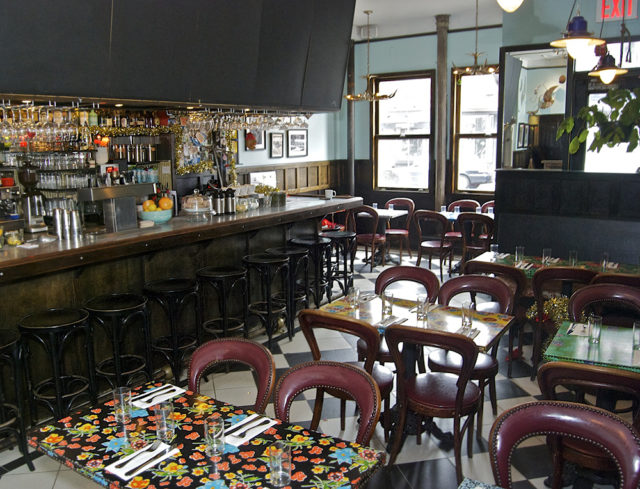 Fort Defiance reopened its still-bruised doors right after Thanksgiving, just five weeks after Sandy had threatened to keep them shut for good.
Fort Defiance reopened its still-bruised doors right after Thanksgiving, just five weeks after Sandy had threatened to keep them shut for good.
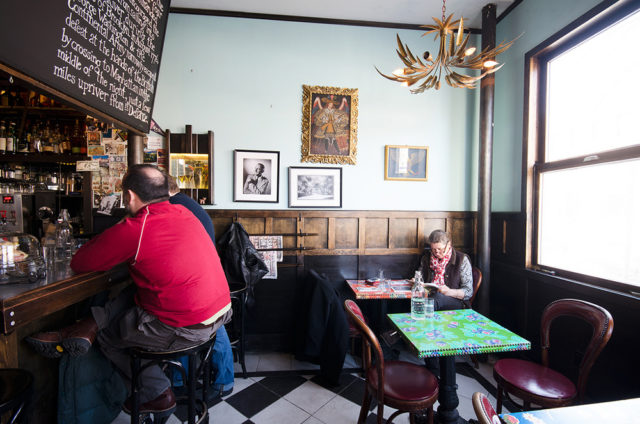 Now Fort Defiance has returned to being a place where Red Hook residents can gather and relax.
Now Fort Defiance has returned to being a place where Red Hook residents can gather and relax.
After the holidays, business really slowed down. St. John and his staff were still replacing and recovering and once again found themselves scraping the bottom of the barrel. He took out a couple of loans to get through the last big repairs needed to finally heal his wounded restaurant. But it was the money lent to him by a dear family friend which finally saved Fort Defiance from oblivion. He’s happy to report both loans will be completely paid off by Spring 2016.
“Fort Defiance is an important part of other people’s lives, not just mine. That’s what I wanted it to be from the beginning, but I never expected this is how I would learn that lesson. People have really stuck by us because this was where their rehearsal dinner was held, where their baby shower was hosted, we’ve even held memorials here. It’s as much a part of their story now as it is mine. It’s inspired me to do a better job of running this place. I almost quit after the storm. Now I can’t. This whole experience really changed my life, my perspective on running Fort Defiance.”
When asked if the events during the Fall of 2012 had brought new perspective on his bar program, St. John paused for a moment and had this to say:
“I used to focus too much on the product and less on the guest and their experience, but I know now, that’s not what it’s all about. I’m a big Charles Baker fan, the cocktail writer. Some people feel a lot of his drink recipes are terrible. And while yes, some of his drinks are not as good as others, that’s not what you should be paying attention to in his cocktails. It’s not just about what’s in the glass, but the experience. What’s going on around you. Baker was really good when it came to the context of a drink. Drinks should be built for an experience, the times we live in, the events in our lives.”
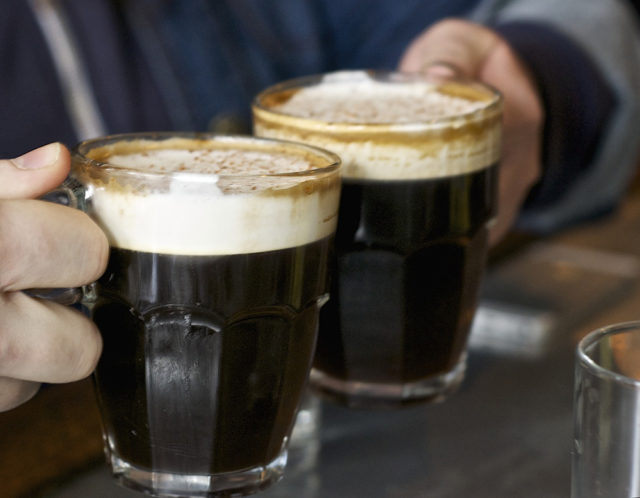 Half the comfort of Fort Defiance is in its accessible drinks that are more about context than complexity; a local favorite is the Irish coffee.
Half the comfort of Fort Defiance is in its accessible drinks that are more about context than complexity; a local favorite is the Irish coffee.
Context. A word that means so much more to St. John now. The experiences of the last three years since Sandy’s savage waters nearly wiped Fort Defiance off the map have created in the restaurant a neighborhood stalwart. A symbol of the scrappy can-doer. A true “Red Hookian.”
“I couldn’t have done this without the countless volunteers, friends, U.S. Bartenders Guild, and our devoted regulars. It’s awesome and humbling to think about. We’re still standing because of them.”
And that may be the lasting legacy of the restaurant. The community, which when she needed them most, rushed to the defense of Fort Defiance.





